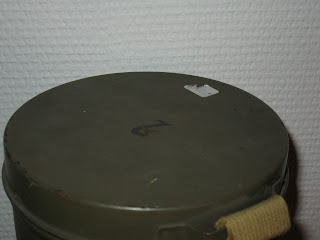The FM series masks were used by Czechoslovakia, Germany (after 1940), The Netherlands, France and a few numbers were purchased by Statens Civile Luftværn during WWII.
Statens Civile Luftværn = A Danish governmental organisation that was founded in 1939 as a part of the "Indenrigsministeriet" - the Danish equivalent to the British Home Office, to help the civil population if under aerial attack.
----------------------------------------------
History:
The FM series masks were produced from the late 1930s into the early first half of the 1940s by the Czech companies: Fatra, Chema, Horak and Kudrnac.
The factory codes for the different companies are:
Fatra: F
Chema: CH
Horak: H
Kurdrnac: K
The FM masks were originally made solely by Fatra since they were the ones with the patent for the masks.
After the annexation the Germans took over production, and used the masks for antiaircraft units. That is why some FM masks are found with a Waffenamt proof stamp.
In Denmark the 'Statens Civile Luftværn' was in desperate need of gas masks during the first years of the war. The M38 civilian gas masks had not been made in sufficient numbers before the war, and since the Danish government already had bought some helmets from Czechoslovakia for the DSB (Danish State Railways), they bought a number of gas masks as well. They bought the "Dutch" version with the 40mm thread, since all gas masks in Danish service (M31 and M38) already used 40mm filters.
In Denmark the masks was designated: Arbejdsgasmaske Model F
Regarding the filter:
There has been a lot of speculations about, whether the filter contained any harmful materials, or not.
The Danish guide mentions that the filter is made of a carbon filter (for filtering chemicals / gasses) and a paper layer for larger particles. It is however NOT made for carbon-monoxide filtering, and it is useless against smoke produced by an ordinary fire.
There is no asbestos in the original Czech filters, but please do NOT use the filters. They have been bashed around for more than 60 years, and whatever there is inside of them does not belong in your lungs.
If you have to parade around with the mask, always do it without the filter, no matter what kind of filter it is. The British WWII filters DO contain asbestos, and are best kept a long way from children.
--------------------------------
There has been a lot of speculations about, whether the filter contained any harmful materials, or not.
The Danish guide mentions that the filter is made of a carbon filter (for filtering chemicals / gasses) and a paper layer for larger particles. It is however NOT made for carbon-monoxide filtering, and it is useless against smoke produced by an ordinary fire.
There is no asbestos in the original Czech filters, but please do NOT use the filters. They have been bashed around for more than 60 years, and whatever there is inside of them does not belong in your lungs.
If you have to parade around with the mask, always do it without the filter, no matter what kind of filter it is. The British WWII filters DO contain asbestos, and are best kept a long way from children.
--------------------------------
My own FM3d gas mask came in its original container, and the only thing missing is the anti-dimming gel. It is often the only thing missing from the war time gas masks, since it was taken out before the masks were put into storage after the war.
It is absolute mint condition, and there is still talcum on the mask. The rubber is soft and very pliable, and all valves work properly. The filter is still sealed with the original cap and tape.
The shoulder strap is not adjustable, but the pamphlet suggest that you tie a knot on the shoulder strap at the desired length.
The lid is held in place by the shoulder strap.
The mask is a size 2. It is most commonly found in a size 2 or 3. The size 1 is perhaps no more than 5-10% of the total number of FM3d masks found in Denmark.
The inhale / exhale valve without cover
The bottom of the filter.
THe filter is produced by Chema, serial number 289 in 1939.
The Chema company logo is stamped into the metal. I have no idea what the CHF-1 stands for.
The ink stamp on the left, is a Czech governmental proof stamp.
The exhale valve cover. The Fatra company was the only company to put their logo on the exhale cover.
----------------------------------------
I've scanned the whole pamphlet that came with the mask. It is in Danish and from 1940.
Enjoy, and if you have any questions, feel free to ask.



















I found one of these mysteriously dumped in a corner, beneath a staircase in my appartment complex just the other day. Only the mask, and nothing else.
ReplyDeleteIt was very dusty and dirty so I gave it a clean just now. It might have been a mistake, rincing it in hot water and soap, because I can see that the rubber has brightened and faded alot now that it has been left to dry.
This one is also of Size 2, and it's stamped as a 'typ 20' imported in 1939. It also has the Trekronor sigil (insignia of the Swedish army) on it.
Anyways, curiosity made me sit down to identify it and I was quite happy to find this blog post.
Seeing that it had bo comments yet, I thought I'd drop one so you'll know someone read and appreciated it.
Cheers!